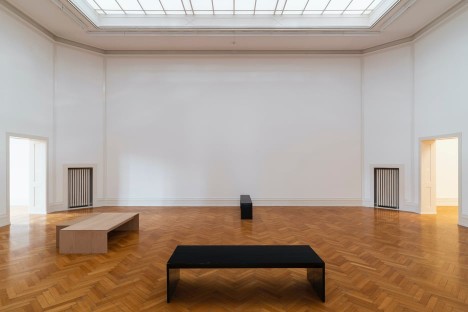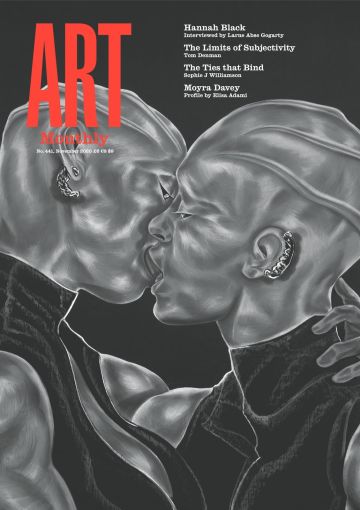Review
Park McArthur: Kunsthalle_guests Gaeste.Netz.5456
Mitchell Anderson on embodiment in the US artist’s audio tour of the gallery space

Park McArthur, A view of Kunsthalle Bern’s main gallery space: light blue ceiling tiles vented upwards, white walls and crown molding, parquet wooden flooring the color of honey. The ceiling’s large circle, star, and grid design elements fill the image’s upper half. A small, two page artwork titled Form found figuring it out, show, 2020 is barely visible from across the large room and two black museum benches sit perpendicular to one another on the floor
The centrepiece of Park McArthur’s exhibition at the Kunsthalle Bern, ‘Kunsthalle_guests Gaeste. Netz.5456’, is a roughly 35-minute soundwork-cum-audio guide that is accessed through the Kunsthalle’s website. This is accompanied by, and made available through, an extension of the institution’s wireless network covering its interior and exterior spaces.
The show’s title communicates network and password in one place, and the work is readily accessible physically and digitally, locally (including at least twice on the radio) and over the connected world. There are a lot of mechanisms at work, some disjointed, but the total effect – and, perhaps, its radicality – is an exhibition fully conceptualised as something that is not to be experienced in person, but online (including its exhibition guide, installation images and external texts) away from the museum.
So far the discussion around this exhibition, including published criticism and my conversations with colleagues and friends, has focused on its emptiness. And, indeed, the institution has a history of notably subtle installations, such as Michael Asher’s moving of the building’s radiators to the entrance hall in 1992 or Maria Eichhorn’s use of her exhibition budget to renovate the building in 2001. Although there are base relations between McArthur’s Wi-Fi gesture and Eichhorn’s, this general road of thought is a misreading, based on location and the art world’s need for historical threads. In addition to the audio guide which, when used as prescribed, fills the entire exhibition, every room also contains physical artworks. Some hold purposely placed objects that not only take up space physically, but also conceptually and spatially. The audio piece, available in German and English, is a tour of the building, grounds and exhibition, redescribing the architecture as one of changing atmospheres as well as the feeling of one’s senses within these spaces. ‘For such a large room the air inside of Hauptsaal is still. A T would appear if you were to draw straight lines between the room’s three open doors,’ declares the guide, for example, continuing elsewhere, ‘39 of Kunsthalle Bern’s 49 windows can be opened. Changes in weather typically come from the North.’ The close attention to the feeling of spatial access and movement is important to McArthur’s brand of conceptualism and is at its most acute when experiencing the exhibition remotely or ‘outside the exhibition’, but the guide also forcefully places what is often discounted by viewers looking at art in exhibition spaces into conscious play.
Two rooms have found plaster versions of Paul Kunz’s lion head sculptures c1918, which also adorn the exterior of the Kunsthalle. Hung low, they mirror their stone counterparts, as if the outside has flipped in, a feeling that is made more literal with McArthur’s opening of the windows and skylights throughout the space as either a warm summer breeze, in the show’s first weeks, or a crisp autumn chill (in opposition to her warming of the Chisenhale Gallery show ‘Poly’ in 2016; see Reviews AM394).
This focus on the inside/outside continues with Form found figuring it out, show, 2020, a two-page diptych mounted to the wall ten times as if a spore throughout the exhibition’s flow. The pages are printed with the markings from a device used to measure and ultimately train users in the corect volume of breath exhalation, but McArthur has inverted these graph readings as if viewed or inhaled from within. Heightening this idea of physical portals they are situated, and paired like the lion heads, at opposing positions around open doorways. But nowhere is this ‘layering within layering’ so strong as with the inclusion of Untitled, 2013, a seven-minute audio work which is embedded within the larger soundwork and made by ‘tracing a small room with a power wheelchair’. This work is audibly beautiful, a generous spectral update of Bruce Nauman’s studio videos of the late 1960s, and personal in a way that leads us towards the universal.
McArthur’s works are typically viewed through a conceptual lens of activism that is informed by issues of physical accessibility and consideration of how viewers’ bodies interact with and privilege space. At the Kunsthalle it is perhaps most keenly experienced with this work listened to within the building’s trapdoor-like freight elevator that rises from the floor before descending inside the building. Within, within, within – McArthur continues to push conceptually.
That the length of the elevator ride down to the remaining show is drastically shorter than the audio-piece is telling of intent and execution. Experiencing the exhibition both physically and at a remove, the timing only lines up when the Kunsthalle becomes an imagined space. In that way it recalls typical judgements of literary cinematic adaptations, where reading characters and scenery are invented within one’s head and where often the experience is richer than having it actualised with sets or the familiar faces of stars.
For the past two decades many artists have negotiated what it means to experience art through a deluge of images beyond the physical encounter, and this is typically conjoined with judgements of what is lost or changed in the process; Gili Tal’s recent exhibition at Galerie Buchholz in Berlin, for instance, used multiple perspectives to present alternate realities in person and online, while her series of installation images shot from her computer screen, Spaces for Reflection, 2019, points to a deadness in viewing art online.
A lot of art, conceptual art in particular, relies on the viewer’s trust in the artist. Narrative must be believed. There is almost no reason for this exhibition to exist physically besides this. It is remarkable that McArthur’s exhibition emanates from a seemingly lost, un-jaded moment – now decades past – where the internet, and the information it grants, offers possibilities of access and critique. It is also laudable to attempt this negotiation with a wider public at its centre, while critically pointing to an institution’s main feat of granting exhibition opportunities as conveyors of status and receiver of art-star shine. There are still lots of unsaid and layered content within this show about physical access, class and creativity, but as long as there is a Kunsthalle Bern and free access to the internet, this exhibition will continue to exfoliate its meanings eternally and be open to being experienced in full.
Mitchell Anderson is an artist and writer based in Zurich where he organises the project space Plymouth Rock.
First published in Art Monthly 441: November 2020.










